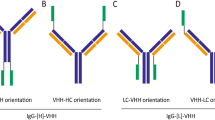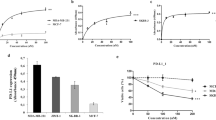Abstract
Blockade of the interaction of the immune checkpoint receptor programmed cell death protein (PD)-1 and its ligand PD-L1 has been found to be a promising cancer treatment. Our previous studies identified that nABPD1 competed with PD-L1 to bind PD-1. The aim of this study was to evaluate the efficacy and safety of anti-tumor immunotherapy of ICIK cells conjugated with peptides in vivo and in vitro. Here, we synthesized the nABPD1 derivatives SBP1 and SBP2 and showed that their binding efficiency to PD-1-positive improving cytokine-induced killer (ICIK) cells was 98 and 82%, respectively. The cytotoxicity of ICIK cells to T-cell acute lymphoblastic leukemia (T-ALL) cells was increased by conjugating with SBP1 or SBP2, which was 2 times higher than that of ICIK cells alone. Furthermore, mice experiments showed that the fluorescence intensity of leukemia cells in T-ALL xenograft models was reduced by more than 95%, indicating that the peptides enhanced the therapeutic effect in vivo, while morphological evaluations showed that the peptides had no toxicity to important organs. Therefore, peptide-cell conjugates (PCCs) may be a novel method to improve the efficacy of cancer immunotherapy by blocking PD-1 in T-ALL patients.





Similar content being viewed by others
Data availability
No new data were created.
References
Iacobucci I, Mullighan CG. Genetic basis of acute lymphoblastic leukemia. J Clin Oncol. 2017;35(9):975–83. https://doi.org/10.1200/jco.2016.70.7836.
Vadillo E, Dorantes-Acosta E, Pelayo R, Schnoor M. T cell acute lymphoblastic leukemia (T-ALL): new insights into the cellular origins and infiltration mechanisms common and unique among hematologic malignancies. Blood Rev. 2018;32(1):36–51. https://doi.org/10.1016/j.blre.2017.08.006.
Kennedy LB, Salama AKS. A review of cancer immunotherapy toxicity. CA Cancer J Clin. 2020;70(2):86–104. https://doi.org/10.3322/caac.21596.
Zhang Y, Zhang Z. The history and advances in cancer immunotherapy: understanding the characteristics of tumor-infiltrating immune cells and their therapeutic implications. Cell Mol Immunol. 2020;17(8):807–21. https://doi.org/10.1038/s41423-020-0488-6.
Sharma A, Schmidt-Wolf IGH. 30 years of CIK cell therapy: recapitulating the key breakthroughs and future perspective. J Exp Clin Cancer Res. 2021;40(1):388. https://doi.org/10.1186/s13046-021-02184-2.
Tanaka J. Recent advances in cellular therapy for malignant lymphoma. Cytotherapy. 2021;23(8):662–71. https://doi.org/10.1016/j.jcyt.2020.12.007.
Sterner RM, Sakemura R, Cox MJ, et al. GM-CSF inhibition reduces cytokine release syndrome and neuroinflammation but enhances CAR-T cell function in xenografts. Blood. 2019;133(7):697–709. https://doi.org/10.1182/blood-2018-10-881722.
Sterner RC, Sterner RM. CAR-T cell therapy: current limitations and potential strategies. Blood Cancer J. 2021;11(4):69. https://doi.org/10.1038/s41408-021-00459-7.
Lee JB, Vasic D, Kang H, Fang KK, Zhang L. State-of-art of cellular therapy for acute leukemia. Int J Mol Sci. 2021;22(9):4590. https://doi.org/10.3390/ijms22094590.
Introna M. CIK as therapeutic agents against tumors. J Autoimmun. 2017;85:32–44. https://doi.org/10.1016/j.jaut.2017.06.008.
Zhang Y, Schmidt-Wolf IGH. Ten-year update of the international registry on cytokine-induced killer cells in cancer immunotherapy. J Cell Physiol. 2020;235(12):9291–303. https://doi.org/10.1002/jcp.29827.
Zhang Y, Ellinger J, Ritter M, Schmidt-Wolf IGH. Clinical studies applying cytokine-induced killer cells for the treatment of renal cell carcinoma. Cancers (Basel). 2020;12(9):2471. https://doi.org/10.3390/cancers12092471.
Sommaggio R, Cappuzzello E, Dalla Pietà A, et al. Adoptive cell therapy of triple negative breast cancer with redirected cytokine-induced killer cells. Oncoimmunology. 2020;9(1):1777046. https://doi.org/10.1080/2162402x.2020.1777046.
Zhang L, Ding J, Li HY, Wang ZH, Wu J. Immunotherapy for advanced hepatocellular carcinoma, where are we? Biochim Biophys Acta Rev Cancer. 2020;1874(2):188441. https://doi.org/10.1016/j.bbcan.2020.188441.
Yu SJ, Ma C, Heinrich B, et al. Targeting the crosstalk between cytokine-induced killer cells and myeloid-derived suppressor cells in hepatocellular carcinoma. J Hepatol. 2019;70(3):449–57. https://doi.org/10.1016/j.jhep.2018.10.040.
Kim HM, Kang JS, Lim J, et al. Inhibition of human ovarian tumor growth by cytokine-induced killer cells. Arch Pharm Res. 2007;30(11):1464–70. https://doi.org/10.1007/bf02977372.
Jiang P, Zhang Y, Archibald SJ, Wang H. Adoptive cell transfer after chemotherapy enhances survival in patients with resectable HNSCC. Int Immunopharmacol. 2015;28(1):208–14. https://doi.org/10.1016/j.intimp.2015.05.042.
Huang X, Zhang J, Li X, et al. Rescue of iCIKs transfer from PD-1/PD-L1 immune inhibition in patients with resectable tongue squamous cell carcinoma (TSCC). Int Immunopharmacol. 2018;59:127–33. https://doi.org/10.1016/j.intimp.2018.04.011.
Ok CY, Young KH. Targeting the programmed death-1 pathway in lymphoid neoplasms. Cancer Treat Rev. 2017;54:99–109. https://doi.org/10.1016/j.ctrv.2017.01.009.
Keir ME, Butte MJ, Freeman GJ, Sharpe AH. PD-1 and its ligands in tolerance and immunity. Annu Rev Immunol. 2008;26:677–704. https://doi.org/10.1146/annurev.immunol.26.021607.090331.
Ansell SM, Lesokhin AM, Borrello I, et al. PD-1 blockade with nivolumab in relapsed or refractory Hodgkin’s lymphoma. N Engl J Med. 2015;372(4):311–9. https://doi.org/10.1056/NEJMoa1411087.
Garon EB, Rizvi NA, Hui R, et al. Pembrolizumab for the treatment of non-small-cell lung cancer. N Engl J Med. 2015;372(21):2018–28. https://doi.org/10.1056/NEJMoa1501824.
Ribas A, Wolchok JD. Cancer immunotherapy using checkpoint blockade. Science. 2018;359(6382):1350–5. https://doi.org/10.1126/science.aar4060.
Verma V, Sprave T, Haque W, et al. A systematic review of the cost and cost-effectiveness studies of immune checkpoint inhibitors. J Immunother Cancer. 2018;6(1):128. https://doi.org/10.1186/s40425-018-0442-7.
Kraehenbuehl L, Weng CH, Eghbali S, Wolchok JD, Merghoub T. Enhancing immunotherapy in cancer by targeting emerging immunomodulatory pathways. Nat Rev Clin Oncol. 2022;19(1):37–50. https://doi.org/10.1038/s41571-021-00552-7.
Chang HN, Liu BY, Qi YK, et al. Blocking of the PD-1/PD-L1 interaction by a D-Peptide antagonist for cancer immunotherapy. Angew Chem Int Ed Engl. 2015;54(40):11760–4. https://doi.org/10.1002/anie.201506225.
Chen Y, Huang H, Liu Y, et al. Engineering a high-affinity PD-1 peptide for optimized immune cell-mediated tumor therapy. Cancer Res Treat. 2022;54(2):362–74. https://doi.org/10.4143/crt.2021.424.
Zhang X, Schwartz JC, Guo X, et al. Structural and functional analysis of the costimulatory receptor programmed death-1. Immunity. 2004;20(3):337–47. https://doi.org/10.1016/s1074-7613(04)00051-2.
Li Y, Sharma A, Bloemendal M, Schmidt-Wolf R, Kornek M, Schmidt-Wolf IGH. PD-1 blockade enhances cytokine-induced killer cell-mediated cytotoxicity in B-cell non-Hodgkin lymphoma cell lines. Oncol Lett. 2021;22(2):613. https://doi.org/10.3892/ol.2021.12874.
Han Y, Mu D, Liu T, et al. Autologous cytokine-induced killer (CIK) cells enhance the clinical response to PD-1 blocking antibodies in patients with advanced non-small cell lung cancer: a preliminary study. Thorac Cancer. 2021;12(2):145–52. https://doi.org/10.1111/1759-7714.13731.
Zhou L, Chen Q, Chen H, Wang L, Zhang J. Enhanced inhibitory effect of DC-CIK cells on lung adenocarcinoma via Anti-Tim-3 antibody and antiprogrammed cell death-1 antibody and possible mechanism. Evid Based Complement Alternat Med. 2022;2022:4097576. https://doi.org/10.1155/2022/4097576.
Dehno MN, Li Y, Weiher H, Schmidt-Wolf IGH. Increase in efficacy of checkpoint inhibition by cytokine-induced-killer cells as a combination immunotherapy for renal cancer. Int J Mol Sci. 2020;21(9):3078. https://doi.org/10.3390/ijms21093078.
Liu S, Meng Y, Liu L, et al. CD4(+) T cells are required to improve the efficacy of CIK therapy in non-small cell lung cancer. Cell Death Dis. 2022;13(5):441. https://doi.org/10.1038/s41419-022-04882-x.
Li C, Zhang N, Zhou J, et al. Peptide blocking of PD-1/PD-L1 interaction for cancer immunotherapy. Cancer Immunol Res. 2018;6(2):178–88. https://doi.org/10.1158/2326-6066.Cir-17-0035.
Kotraiah V, Phares TW, Browne CD, et al. Novel peptide-based PD1 immunomodulators demonstrate efficacy in infectious disease vaccines and therapeutics. Front Immunol. 2020;11:264. https://doi.org/10.3389/fimmu.2020.00264.
Vlieghe P, Lisowski V, Martinez J, Khrestchatisky M. Synthetic therapeutic peptides: science and market. Drug Discov Today. 2010;15(1–2):40–56. https://doi.org/10.1016/j.drudis.2009.10.009.
Li CM, Haratipour P, Lingeman RG, et al. Novel peptide therapeutic approaches for cancer treatment. Cells. 2021;10(11):2908. https://doi.org/10.3390/cells10112908.
Alharbi N, Skwarczynski M, Toth I. The influence of component structural arrangement on peptide vaccine immunogenicity. Biotechnol Adv. 2022;60: 108029. https://doi.org/10.1016/j.biotechadv.2022.108029.
De Groot AS, Roberts BJ, Mattei A, Lelias S, Boyle C, Martin WD. Immunogenicity risk assessment of synthetic peptide drugs and their impurities. Drug Discov Today. 2023;28(10): 103714. https://doi.org/10.1016/j.drudis.2023.103714.
Aroda VR, Blonde L, Pratley RE. A new era for oral peptides: SNAC and the development of oral semaglutide for the treatment of type 2 diabetes. Rev Endocr Metab Disord. 2022;23(5):979–94. https://doi.org/10.1007/s11154-022-09735-8.
Zaman R, Islam RA, Ibnat N, et al. Current strategies in extending half-lives of therapeutic proteins. J Control Release. 2019;301:176–89. https://doi.org/10.1016/j.jconrel.2019.02.016.
Acknowledgements
We thank Yingxia Wu and Chuying Zhang (staff in the Instrument and Equipment Center, School of Life Sciences, Sun Yat-sen University, China) for their support in the process of using flow cytometry and confocal microscopy.
Funding
This research was funded by the Programs of Guangdong Science and Technology Department (No. 2016B030231001; No. 2017B020230002) and the Natural Science Foundation of China (31871413, 32100627), and the GuangDong Basic and Applied Basic Research Foundation (No. 2022A1515110025).
Author information
Authors and Affiliations
Corresponding author
Ethics declarations
Conflict of interest
Conflict of interest relevant to this article was not reported.
Additional information
Publisher's Note
Springer Nature remains neutral with regard to jurisdictional claims in published maps and institutional affiliations.
Supplementary Information
Below is the link to the electronic supplementary material.
Rights and permissions
Springer Nature or its licensor (e.g. a society or other partner) holds exclusive rights to this article under a publishing agreement with the author(s) or other rightsholder(s); author self-archiving of the accepted manuscript version of this article is solely governed by the terms of such publishing agreement and applicable law.
About this article
Cite this article
Wang, Q., Huang, H., Liang, P. et al. Development of PD-1 blockade peptide-cell conjugates to enhance cellular therapies for T-cell acute lymphoblastic leukemia. Med Oncol 41, 14 (2024). https://doi.org/10.1007/s12032-023-02235-y
Received:
Accepted:
Published:
DOI: https://doi.org/10.1007/s12032-023-02235-y




